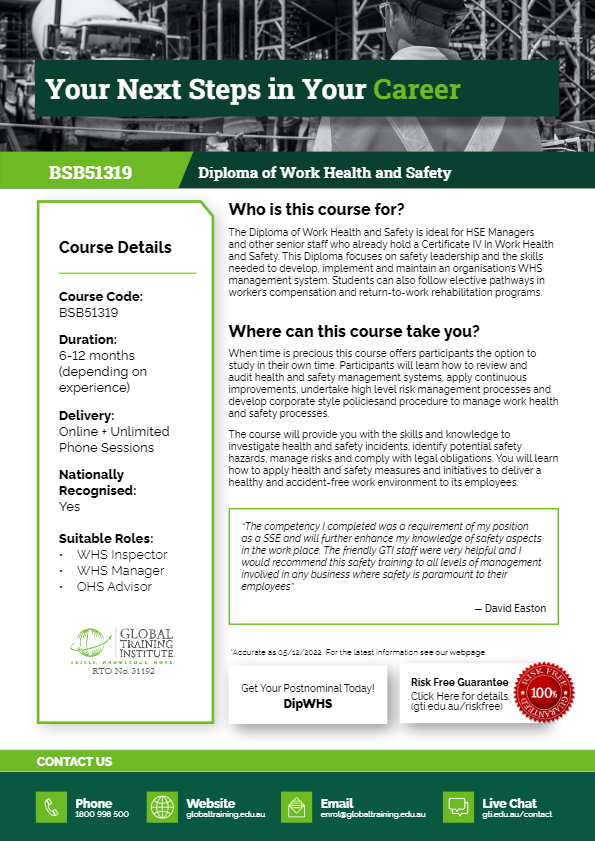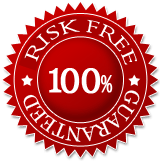Finally an online course that has been designed for people who are wanting to work in health and safety management field at an organisational level…
Where can this course take you?
When time is precious this course offers participants the option to study in their own time. Participants will learn how to review and audit health and safety management systems, apply continuous improvements, undertake high level risk management processes and develop corporate style policies and procedure to manage work health and safety processes.
If you are a great motivator and investigator – and are passionate about the mental, physical and emotional wellbeing of your team mates – the Diploma of Work Health and Safety can give you the skills you need for a rewarding career.
The course will provide you with the skills and knowledge to investigate health and safety incidents, identify potential safety hazards, manage risks and comply with legal obligations. You will learn how to apply health and safety measures and initiatives to ensure that the organisation complies with work health and safety legislation and workplace policies to deliver a healthy and accident-free work environment to its employees.
Code: BSB51319
Units: 10
Length: 6-12 months (depending on experience)
Start Dates: Flexible, year-round
RPL Available: Yes
Delivery: Online
Funding Assistance: Click Here
Code: BSB51319
Units: 10
Length: 6-12 months (depending on experience)
Start Dates: Flexible, year-round
RPL Available: Yes
Delivery: Online
Funding Assistance: Click Here
Finally an online course that has been designed for people who are wanting to work in health and safety management field at an organisational level…
Where can this course take you?
When time is precious this course offers participants the option to study in their own time. Participants will learn how to review and audit health and safety management systems, apply continuous improvements, undertake high level risk management processes and develop corporate style policies and procedure to manage work health and safety processes.
If you are a great motivator and investigator – and are passionate about the mental, physical and emotional wellbeing of your team mates – the Diploma of Work Health and Safety can give you the skills you need for a rewarding career.
The course will provide you with the skills and knowledge to investigate health and safety incidents, identify potential safety hazards, manage risks and comply with legal obligations. You will learn how to apply health and safety measures and initiatives to ensure that the organisation complies with work health and safety legislation and workplace policies to deliver a healthy and accident-free work environment to its employees.
Progress Your Career to become a…
As a WHS Director, you will be responsible for leading a diverse team of safety specialists in a coordinated effort to reduce safety hazards in the workplace. This can involve liaising between different safety technicians, utilizing their insights and your management experience to produce a systematic safety strategy that deals with safety hazards at all levels of your organisation.
In this role you will often be training employees in the correct use of personal protective equipment (PPE), and appropriate workplace guidelines to ensure safety and reduce risk of injury. In the event an injury occurs, you will be responsible for recording and investigating the incident, assisting injured staff through compensation procedures as appropriate, and facilitating their return to the workplace.
As a OHS Supervisor, you will often be reporting to the WHS Director, informing them of the results from any relevant safety test conducted in the workplace. You may need to collate relevant regulations and ensure compliance with them. Acting as the liaison between any safety technicians and other employees, you will bring any relevant concerns or test results to the WHS Director and work with them to produce a coordinated safety strategy for the workplace.
Who is this course for?
It is ideal for those already working in a WHS role looking to upskill and gain career advantage. Recognition of Prior Learning (RPL) is available.
Completion of the BSB51319 Diploma in Work Health and Safety combined with suitable experience provides the opportunity to become a supervisor/manager or WHS Co-ordinator/supervisor/manager.
Diploma of Work Health and Safety (BSB51319) – for HSE Managers and other senior staff who already hold a Certificate IV In Work Health and Safety. This Diploma focuses on safety leadership and the skills needed to develop, implement and maintain an organisation’s WHS management system. Students can also follow elective pathways in worker’s compensation and return-to-work rehabilitation programs.
Who is this course for?
It is ideal for those already working in a WHS role looking to upskill and gain career advantage. Recognition of Prior Learning (RPL) is available.
Completion of the BSB51319 Diploma in Work Health and Safety combined with suitable experience provides the opportunity to become a supervisor/manager or WHS Co-ordinator/supervisor/manager.
Diploma of Work Health and Safety (BSB51319) – for HSE Managers and other senior staff who already hold a Certificate IV In Work Health and Safety. This Diploma focuses on safety leadership and the skills needed to develop, implement and maintain an organisation’s WHS management system. Students can also follow elective pathways in worker’s compensation and return-to-work rehabilitation programs.
Course Overview
COURSE: Diploma of Work Health and Safety
CODE: BSB51319
IDEAL FOR: WHS Inspector, WHS Manager, OHS Advisor
UNITS: 10
DURATION: 6-12 months (depending on experience)
DELIVERY: Online + Unlimited Phone Sessions
ENTRY REQUIREMENTS:
Age: 25 Years or over
Academic Suitability: Proof of completing:
– Year 12/Senior Certificate; or
– An AQF Qualification at Level 4 or above (Australian Certificate IV, Diploma, University Degree); or
– Pass a Government approved LLN Test. (You must display competence at or above Exit level 3 in both numeracy and literacy)
Mandatory Prerequisites:
To successfully enrol into this course each participant must submit a copy of their completed BSB41412, BSB41415 or BSB41419 Certificate IV in Work Health and Safety Statement of Results showing completion of the following core units of competency:
– BSBWHS412 Assist with workplace compliance with WHS laws (or BSBWHS402A, BSBWHS402)
– BSBWHS413 Contribute to implementation and maintenance of WHS consultation and participation processes (or BSBWHS403A, BSBWHS403)
– BSBWHS414 Contribute to WHS risks management (or BSBWHS404A, BSBWHS404)
– BSBWHS415 Contribute to implementing WHS management systems (or BSBWHS405A, BSBWHS405)
– BSBWHS416 Contribute to workplace incident response (or BSBWHS406A, BSBWHS406)
A statement of results showing completion of the above prerequisites must be provided at enrolment into the Diploma. Please note that BSB41407 – Certificate IV in Occupational Health and Safety is not equivalent, and does not meet the prerequisite requirements
English language: see ‘English Requirements’ in the footer of the website for more information.
Resource Requirements: Students are required to have access to the internet and a computer in order to access their materials online.
General: Motivation and good reason to complete qualification
NOTE: If an applicant does not meet the following criteria but believes they are capable, they will need to book a meeting with the Training Manager/Director and the enrolment may be accepted at their discretion.
*Requirements listed here do not apply to Traineeship qualifications.
START DATES: Flexible, Year Round
FUNDING ASSISTANCE: Click Here
Why complete your qualification with GTI?
-
Help gain your next Promotion
-
Formally recognise your work skills
-
Prove your experience
-
Learn new skills
-
No heavy theory, no essays, no exams
-
Online 24/7 access to resources and assessments
-
Training and assessments that relate to Your work and industry
Units
There are 10 units in this qualification. Your units may differ depending if you have credits, if you are completing another qualification also at the same time or if you have chosen different electives.
Mandatory Prerequisites
To successfully enrol into this course each participant must submit a copy of their completed BSB41412, BSB41415 or BSB41419 Certificate IV in Work Health and Safety Statement of Results showing completion of the following core units of competency:
BSBWHS412 Assist with workplace compliance with WHS laws (or BSBWHS402A, BSBWHS402)
BSBWHS413 Contribute to implementation and maintenance of WHS consultation and participation processes (or BSBWHS403A, BSBWHS403)
BSBWHS414 Contribute to WHS risks management (or BSBWHS404A, BSBWHS404)
BSBWHS415 Contribute to implementing WHS management systems (or BSBWHS405A, BSBWHS405)
BSBWHS416 Contribute to workplace incident response (or BSBWHS406A, BSBWHS406)
A statement of results showing completion of the above prerequisites must be provided at enrolment into the Diploma. Please note that BSB41407 – Certificate IV in Occupational Health and Safety is not equivalent, and does not meet the prerequisite requirements.




